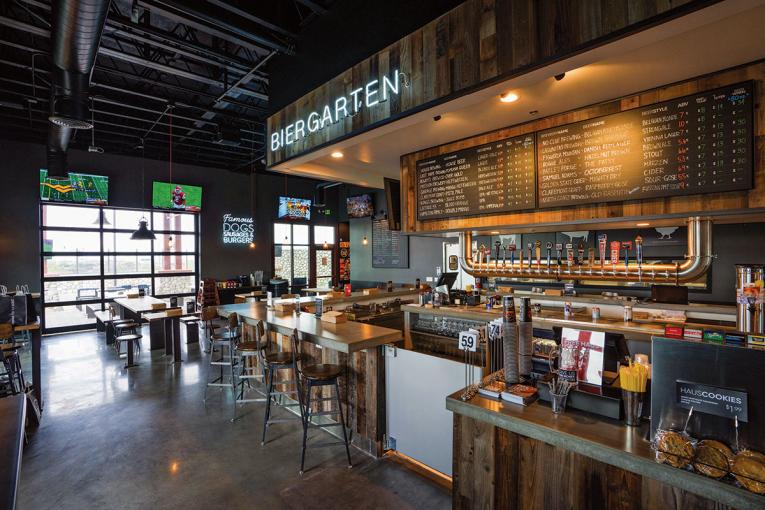As technology becomes increasingly essential to all facets of a restaurant operation, brands and third-party partners are exploring how new advancements can enhance onboarding and training. For hot dog and burger concept Dog Haus, that meant teaming up with 1Huddle to put a fresh spin on the process. The training platform uses gamification to turn employee handbooks into interactive games that team members play in lieu of traditional training seminars and reading.
CJ Ramirez, executive vice president of marketing at Dog Haus, says the program enhances how employees engage with the material; the interactive format also fits the varied learning styles different people have. These games, he adds, are especially helpful for servers at Dog Haus Biergarten, a full-service version of the original fast casual.
Dog Haus is committed to being a technology-forward company, Ramirez says, so instilling that mindset from the very beginning ensures employees understand and champion this ethos. Here, he offers a behind-the-scenes look into the new onboarding process.
How did you turn onboarding into a literal game?
1Huddle made it super turnkey. They said, ‘Give us all your training manuals, and we’ll turn them into games; if you don’t like what we’ve done, go ahead and edit them, but we think that after you see what we’ve done with your material, you’ll understand how to create more games.’
Then we can create the additional components that aren’t in a printed piece, which would be motion and audio, as well as feedback. It really is amazing how you can do that. We had a meeting with 1Huddle, and that really encouraged us to go after it. They immediately flip your training materials into games for you to reference and understand, and then they input it into their system, their dashboard.
How have staff reacted to the ‘gamification’?
Logistically, on the user side, all they need is a mobile device and a login, so it’s super easy. I think one more layer is that we have found a way to incentivize the user to play the games. Early on, there was a question regarding, ‘Am I allowed to play at work?’ We had to re-engineer the expectation, so we incorporated playtime in the work shift. We work with our franchisees to implement that type of approach and then we move to monitoring who’s playing and recognizing those that accumulate the most points or play for the longest period of time or the ultimate top player in their location, in their state, or in the company.
What differentiates your onboarding process from other tech-forward ones?
1Huddle gives us that ability to reach everybody in their learning style, so that’s really where we’re taking it to the next level. When we initially started years ago, we thought one game was enough for everybody, but we’ve learned it isn’t when you account for learning styles. We try to make the games as dynamic as possible.
The feedback we’re receiving from our users is, ‘This is really fun. It works for me.’ Employees are surprised that they begin to enjoy learning. So for us, that’s really positive feedback. Now the negative feedback is, ‘Why do I need to play it again? It’s the same game from last month.’ And we say yes, but it’s part of a package; it’s a curriculum. Comments like that are answered with ‘Yeah, but it’s going to make you faster at it, and it’s just reinforcing the information. And then people say OK, I get it.’
How has the new system helped your servers?
We always want to maintain our stance that everything we say and everything we do is genuine; we’re not making stuff up. So, the most important thing is for our team members to be well informed because the best interaction is natural. If they can answer quickly as opposed to just reading the script off, that’s very important for them.
For example, with bartenders, when someone says, ‘This is a pretty good beer, but it might be a little hoppy for me. I’d like to try something else,’ we encourage them to add personal touches. We let our team members share their personal experiences. That’s really one of the hardest questions.
We train all the time, and the most challenging question you get is, ‘What’s your favorite hot dog, burger, or beer. What we like to say is you can have a favorite, because at Dog Haus, the menu is so wide.
You can eat light, or you can leave with a very full stomach; there’s a wide selection. But you really have to contextualize what they are in the mood for, because it demonstrates to the receiver that staff know more than just the menu. When someone asks, ‘What’s your favorite?’ and the question is answered with an immediate item, it does not allow for the team member to educate the customer on our full menu.
Why is this program the right fit for your company culture?
We’re in the middle of opening about seven locations, so it’s crazy. Everyone is onboarding at different times and we’re making sure everyone is playing the franchisee game, the employee game, the general manager game—all of this curriculum we have out there. Pretty much everybody that’s part of the Dog Haus world is using technology because our brand is very technology-forward, and that attracts a lot of franchisees to us.
When we go through Discovery Days, they ask me to tell them more about the technology, about what type of general manager they should hire.
In the past, if you were lucky, you would hire someone to run your store with 20 or 30 years of experience who came out of some of the best restaurant brands that we all know today.
But my question is, how adaptable are they and how comfortable are they with technology? Because we use a lot of tech at Dog Haus, and if you hire someone that’s not comfortable with tech, that’s a problem.










